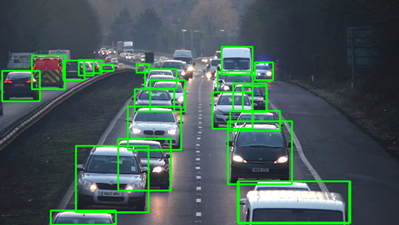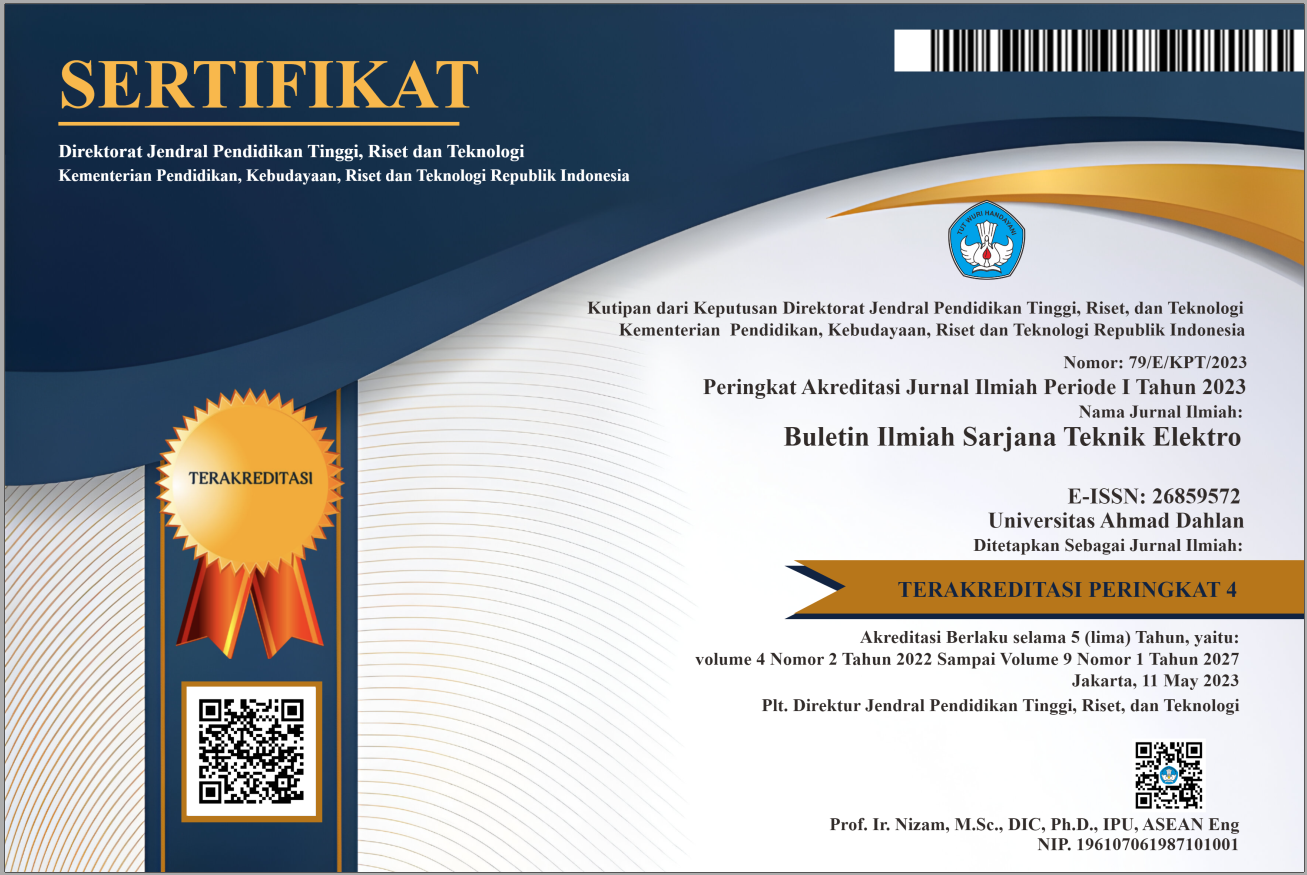Random Multi-Augmentation to Improve TensorFlow-Based Vehicle Plate Detection
DOI:
https://doi.org/10.12928/biste.v6i2.10542Keywords:
TensorFlow, Augmentation, Vehicle Number Plate, Detection, EdukitAbstract
In the development of the "Machine Learning" education kit, vehicle plate recognition was created using TensorFlow with SSD MobileNetV2. The detection failure rate in the training process with varying distances and lighting from the camera is high if the training data is insufficient. Addressing that notable gap in research, we proposed Random Multi-Augmentation to Improve TensorFlow-Based Vehicle Plate Detection. Augmentation techniques are expected to train data that is manipulated at varying lighting and distance. The proposed method consists of two combining augmentation approaches, namely: position augmentation and lighting augmentation. Position augmentation which consists of Flip, Crop, Rotate, Shift, and Crop is used to enrich the visualization of distance and viewing angle, while Lighting augmentation which consists of Greyscale, Hue, Saturation, Brightness, Exposure, and Blur is used to enrich the visualization of lighting. Variations in values were determined randomly based on variations in values from several previous studies. The comparison of TensorFlow SSD MobileNetV2 and Augmentation were tested using one video Roboflow. TensorFlow without augmentation exhibited an accuracy of 60%, precision of 100%, recall of 60%, and an F1 score of 75%, whereas TensorFlow within augmentation achieved a higher accuracy of 70%, precision of 100%, recall of 70%, and an F1 score of 82.3%. Based on precision measurement, Tensorflow can be claimed to prevent false positives, which indicates that the algorithm did not detect non-plate objects as vehicle plates. Furthermore, a comparison of the use of augmentation shows an increase in plate detection capabilities when using augmentation as Tensorflow preprocessing, which is indicated by an increase in recall and accuracy values. These results emphasize that augmentation is the pre-processing optimizer for vehicle number plate systems.
References
A. Ait Ouallane, A. Bakali, A. Bahnasse, S. Broumi, and M. Talea, “Fusion of engineering insights and emerging trends: Intelligent urban traffic management system,” Inf. Fusion, vol. 88, pp. 218–248, 2022, https://doi.org/10.1016/j.inffus.2022.07.020.
X. Yang and X. Wang, “Recognizing License Plates in Real-Time,” arXiv preprint arXiv:1906.04376, 2019, https://doi.org/10.48550/arXiv.1906.04376.
G. Boquet, A. Morell, J. Serrano, and J. L. Vicario, “A variational autoencoder solution for road traffic forecasting systems: Missing data imputation, dimension reduction, model selection and anomaly detection,” Transp. Res. Part C Emerg. Technol., vol. 115, p. 102622, 2020, https://doi.org/10.1016/j.trc.2020.102622.
M. Gupta, H. Miglani, P. Deo, and A. Barhatte, “Real-time traffic control and monitoring,” e-Prime - Adv. Electr. Eng. Electron. Energy, vol. 5, p. 100211, 2023, https://doi.org/10.1016/j.prime.2023.100211.
I. Taufiq, B. Purnomosidi, M. A. Nugroho, and A. Dahlan, “Real-time Vehicle License Plate Detection by Using Convolutional Neural Network Algorithm with Tensorflow,” in 2018 2nd Borneo International Conference on Applied Mathematics and Engineering (BICAME), 2018, pp. 275–279, https://doi.org/10.1109/BICAME45512.2018.1570513024.
A. Ashrafee, A. M. Khan, M. S. Irbaz, and M. A. Al Nasim, “Real-time Bangla License Plate Recognition System for Low Resource Video-based Applications,” Proc. - 2022 IEEE/CVF Winter Conf. Appl. Comput. Vis. Work. WACVW 2022, pp. 479–488, 2022, https://doi.org/10.1109/WACVW54805.2022.00054.
K. Khan, A. Imran, H. Z. U. Rehman, A. Fazil, M. Zakwan, and Z. Mahmood, “Performance enhancement method for multiple license plate recognition in challenging environments,” Eurasip J. Image Video Process., vol. 2021, no. 1, 2021, https://doi.org/10.1186/s13640-021-00572-4.
V. Gnanaprakash, N. Kanthimathi, and N. Saranya, “Automatic number plate recognition using deep learning,” In IOP Conference series: materials science and engineering, vol. 1084, no. 1, p. 012027, 2021, https://doi.org/10.1088/1757-899X/1084/1/012027.
E. Haghighat and R. Juanes, “SciANN: A Keras/TensorFlow wrapper for scientific computations and physics-informed deep learning using artificial neural networks,” Comput. Methods Appl. Mech. Eng., vol. 373, p. 113552, 2021, https://doi.org/10.1016/j.cma.2020.113552.
A. Gautam, D. Rana, S. Aggarwal, S. Bhosle, and H. Sharma, “Deep learning approach to automatically recognise license number plates,” Multimed. Tools Appl., vol. 82, no. 20, pp. 31487–31504, 2023, https://doi.org/10.1007/s11042-023-15020-w.
A. Y. Sugiyono, K. Adrio, K. Tanuwijaya, and K. M. Suryaningrum, “Extracting Information from Vehicle Registration Plate using OCR Tesseract,” Procedia Computer Science, vol. 227, pp. 932-938, 2023, https://doi.org/10.1016/j.procs.2023.10.600.
P. Sharma, S. Gupta, P. Singh, K. Shejul, and D. Reddy, “Automatic Number Plate Recognition and Parking Management,” in 2022 International Conference on Advances in Computing, Communication and Applied Informatics (ACCAI), pp. 1–8, 2022, https://doi.org/10.1109/ACCAI53970.2022.9752632.
A. S. Tote, S. S. Pardeshi, and A. D. Patange, “Automatic number plate detection using TensorFlow in Indian scenario: An optical character recognition approach,” Mater. Today Proc., vol. 72, pp. 1073–1078, 2023, https://doi.org/10.1016/j.matpr.2022.09.165.
S. Theodoridis and K. Koutroumbas. Pattern recognition. Elsevier. 2006. https://books.google.co.id/books?hl=id&lr=&id=gAGRCmp8Sp8C.
Q. Zhu, L. Fan, and N. Weng, “Advancements in point cloud data augmentation for deep learning: A survey,” Pattern Recognit., vol. 153, p. 110532, 2024, https://doi.org/10.1016/j.patcog.2024.110532.
H. Kumdakcı, C. Öngün, and A. Temizel, “Generative data augmentation for vehicle detection in aerial images,” In Pattern Recognition. ICPR International Workshops and Challenges: Virtual Event, January 10-15, 2021, Proceedings, Part VII, pp. 19–31, 2021, https://doi.org/10.1007/978-3-030-68793-9_2.
X.-Z. Chen, C.-P. Cheng, and Y.-L. Chen, “Data Augmentation Method for Improving Vehicle Detection and Recognition Performance,” in 2022 IEEE International Conference on Consumer Electronics - Taiwan, pp. 419–420, 2022, https://doi.org/10.1109/ICCE-Taiwan55306.2022.9869222.
X. Wang, S. Yang, Y. Xiao, X. Zheng, S. Gao, and J. Zhou, “A vehicle classification model based on deep active learning,” Pattern Recognit. Lett., vol. 171, pp. 84–91, 2023, https://doi.org/10.1016/j.patrec.2023.05.009.
R. D. Castro-Zunti, J. Yépez, and S. B. Ko, “License plate segmentation and recognition system using deep learning and OpenVINO,” IET Intell. Transp. Syst., vol. 14, no. 2, pp. 119–126, 2020, https://doi.org/10.1049/iet-its.2019.0481.
S. M. Silva and C. R. Jung, “Real-time license plate detection and recognition using deep convolutional neural networks,” J. Vis. Commun. Image Represent., vol. 71, p. 102773, 2020, https://doi.org/10.1016/j.jvcir.2020.102773.
O. Bulan, V. Kozitsky, P. Ramesh, and M. Shreve, “Segmentation- and Annotation-Free License Plate Recognition With Deep Localization and Failure Identification,” IEEE Trans. Intell. Transp. Syst., vol. 18, no. 9, pp. 2351–2363, 2017, https://doi.org/10.1109/TITS.2016.2639020.
S. Yang, W. Xiao, M. Zhang, S. Guo, J. Zhao, and F. Shen, “Image data augmentation for deep learning: A survey,” arXiv preprint arXiv:2204.08610, 2022, https://doi.org/10.48550/arXiv.2204.08610.
W. Sapitri, Y. N. Kunang, I. Z. Yadi, and M. Mahmud, “The Impact of Data Augmentation Techniques on the Recognition of Script Images in Deep Learning Models,” J. Online Inform., vol. 8, no. 2, pp. 169–176, 2023, https://doi.org/10.15575/join.v8i2.1073.
M. Momeny et al., “Learning-to-augment strategy using noisy and denoised data: Improving generalizability of deep CNN for the detection of COVID-19 in X-ray images,” Comput. Biol. Med., vol. 136, p. 104704, 2021, https://doi.org/10.1016/j.compbiomed.2021.104704.
B. Bischl et al., “Hyperparameter optimization: Foundations, algorithms, best practices, and open challenges,” Wiley Interdiscip. Rev. Data Min. Knowl. Discov., vol. 13, no. 2, pp. 1–43, 2023, https://doi.org/10.1002/widm.1484.
K. C. Kirana, S. Wibawanto, A. Hamdan, and W. N. Hidayat, “Optimization of 2D-CNN Setting for the Classification of Covid Disease Using Lung CT Scan,” vol. 1, pp. 143–149, 2022, https://doi.org/10.21609/jiki.v15i2.1083.
K. C. Kirana, S. Wibawanto, N. Hidayah, and G. P. Cahyono, “Improved Neural Network using Integral-RELU based Prevention Activation for Face Detection,” Int. Conf. Electr. Electron. Inf. Eng., vol. 6, pp. 260-263, 2019, https://doi.org/10.1109/ICEEIE47180.2019.8981443.
K. C. Kirana, S. Wibawanto, N. Hidayah, and G. P. Cahyono, “The Improved Artificial Neural Network based on Cosine Similarity for Facial Emotion Recognition,” Int. Conf. Electr. Eng. Comput. Sci. Informatics, pp. 45-48, 2019, https://doi.org/10.23919/EECSI48112.2019.8977006.
S. Khazaee, A. Tourani, S. Soroori, A. Shahbahrami, and C. Y. Suen, “A real-time license plate detection method using a deep learning approach,” In International Conference on Pattern Recognition and Artificial Intelligence (pp. 425-438, 2020, https://doi.org/10.1007/978-3-030-59830-3_37.
K. C. Kirana, G. D. K. Ningrum, D. U. Soraya, F. Alqodri, A. A. Mubarak, and S. Wibawanto, “Synchronization of the Internship Registration System using a Study Plan and Acceptance Letter Based on Tesseract-OCR and Template Matching,” in 2023 8th International Conference on Electrical, Electronics and Information Engineering (ICEEIE), pp. 1–6, 2023, https://doi.org/10.1109/ICEEIE59078.2023.10334686.
D. Talukder and F. Jahara, “Real-Time Bangla Sign Language Detection with Sentence and Speech Generation,” in 2020 23rd International Conference on Computer and Information Technology (ICCIT), pp. 1–6, 2020, https://doi.org/10.1109/ICCIT51783.2020.9392693.

Downloads
Published
How to Cite
Issue
Section
License
Copyright (c) 2024 Kartika Candra Kirana, Salah Abdullah Khalil Abdulrahmana

This work is licensed under a Creative Commons Attribution-ShareAlike 4.0 International License.
Authors who publish with this journal agree to the following terms:
- Authors retain copyright and grant the journal right of first publication with the work simultaneously licensed under a Creative Commons Attribution License that allows others to share the work with an acknowledgment of the work's authorship and initial publication in this journal.
- Authors are able to enter into separate, additional contractual arrangements for the non-exclusive distribution of the journal's published version of the work (e.g., post it to an institutional repository or publish it in a book), with an acknowledgment of its initial publication in this journal.
- Authors are permitted and encouraged to post their work online (e.g., in institutional repositories or on their website) prior to and during the submission process, as it can lead to productive exchanges, as well as earlier and greater citation of published work (See The Effect of Open Access).
This journal is licensed under a Creative Commons Attribution-ShareAlike 4.0 International License.



